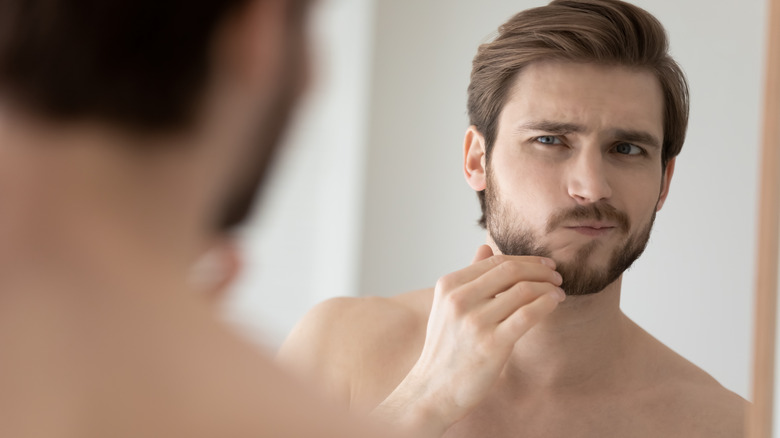How To Identify An Ingrown Hair
An ingrown hair happens when hair doesn't come out of its follicle and grows into the skin instead. This can cause a small, red bump on the skin, which may itch or sting. Ingrown hairs can occur anywhere on the body where hair grows, but they're usually found in areas that are frequently shaved, such as the face, underarms, legs, and pubic area.
Ingrown hairs are common and usually harmless, but they can lead to complications, like an infection. People with curly hair are more likely to experience ingrown hairs, as the hair is more prone to curling back into the skin, per WebMD. The appearance of an ingrown hair can vary depending on the severity of the condition. In some cases, the ingrown hair may be barely noticeable, while it can be more obvious in others. In instances where ingrown hairs are severe or recurrent, it may be necessary to seek medical treatment from a dermatologist or healthcare provider.
Prevention of ingrown hairs can be achieved through several methods, such as proper hair removal techniques, regular exfoliation, and using products that contain salicylic acid or glycolic acid.
What an ingrown hair looks like
One of the most common signs of ingrown hair is redness and inflammation. MedicalNewsToday explains that the skin around the ingrown hair may be inflamed due to an immune response. In some cases, you may be able to see the hair trapped under the skin. It will look like a small, red pimple under the skin's surface. If the hair is visible, it's important not to pull it out, as this can cause an infection if you dig into the skin.
Small bumps may also be a sign of ingrown hair. According to the Cleveland Clinic, these bumps are known as papules and usually appear on the face and neck. The bumps can also grow in size and become filled with pus, resulting in pustules. Ingrown hairs can also cause itching, discomfort, pain, and irritation in the affected area. For this reason, they should be addressed and treated as soon as possible.
How are ingrown hairs treated?
Ingrown hairs can be treated at home with some simple remedies. Exfoliation is an effective option — using a natural product, gentle exfoliation can help remove dead skin cells. The Cleveland Clinic advises using a washcloth or brush to gently scrub the affected area. Applying a warm compress to the affected area can also help reduce inflammation and soothe the skin. Soak a clean cloth in warm water and apply it to the affected area for 10 to 15 minutes. The heat from the compress can help soften the skin and release the trapped hair.
Hair removal methods can also contribute to ingrown hairs. If you frequently develop ingrown hairs, you may want to consider changing your hair removal method. MedicalNewsToday notes that it's best to avoid shaving too close to the skin or pulling the hair out by the roots.
If the ingrown hair is infected or symptoms persist, seeking medical treatment is important. A healthcare provider can help determine the best treatment options, which may include topical or oral antibiotics if there's an infection present.



